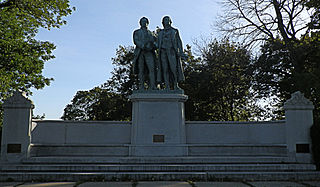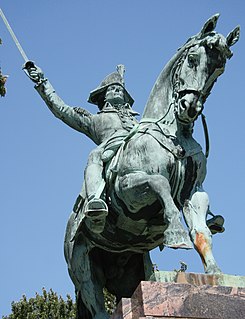
Henry Bergh founded the American Society for the Prevention of Cruelty to Animals (ASPCA) in April, 1866, three days after the first effective legislation against animal cruelty in the United States was passed into law by the New York State Legislature. Bergh also prompted the formation, in 1874, of the Massachusetts Society for the Prevention of Cruelty to Children (MSPCC).

A humane society is a group that aims to stop animal suffering due to cruelty or other reasons. In many countries, the term is used mostly for societies for the prevention of cruelty to animals (SPCA). In the United Kingdom, it may also be a society that provides a waterways rescue, prevention, and recovery service, or that gives awards for the saving of human life.

George Thorndike Angell was an American lawyer, philanthropist, and advocate for the humane treatment of animals.
Richard Henry Park was an American sculptor who worked in marble and bronze. He was commissioned to do work by the wealthy of the nineteenth century. He also created sculptures for the Chicago World's Fair of 1893.

Spirit of Commerce is a public artwork by German artist Gustav Haug located in Jackson Park, which is on the south side of Milwaukee, Wisconsin, United States. This zinc sculpture is 15 feet tall and sits on a red granite pedestal near the park's lagoon. It is the oldest public sculpture in Milwaukee.

The Goethe–Schiller Monument is a public artwork by German artist Ernst Friedrich August Rietschel located in Washington Park, which is in Milwaukee, Wisconsin, United States. The bronze sculpture from 1908 depicts two men, Johann Wolfgang von Goethe and Friedrich von Schiller, one holding a laurel wreath and the other a scroll. The 12 foot artwork rests upon a 26 foot long granite base. The bronze sculpture is a recasting of the statue incorporated into the 1857 Goethe-Schiller Monument in Weimar, Germany.

The Juneau Monument is a public artwork by American artist Richard Henry Park located on the grounds of Juneau Park, which is in Milwaukee, Wisconsin. The base of the statue is made of limestone. On top of the base is a bronze statue of Solomon Juneau. On each side of the base are bronze reliefs. The statue is 5 feet (1.5 m) wide by 15 feet (4.6 m) high.

Leif, the Discoverer is a bronze sculpture of Leif Ericson created by American sculptor Anne Whitney in 1887. It is located at Juneau Park in Milwaukee, Wisconsin, The United States of America.

George Washington is a statue by French sculptor Jean-Antoine Houdon from the late 18th century. Based on a life mask and other measurements of George Washington taken by Houdon, it is considered one of the most accurate depictions of the subject. The original sculpture is located in the rotunda of the Virginia State Capitol in Richmond, Virginia, and has been copied extensively.

The Washington Monument is a public artwork by American artist Richard Henry Park located on the Court of Honor in front of the Milwaukee Public Library Central Library, which is near Marquette University in Milwaukee, Wisconsin. The bronze sculpture is a full-length portrait of a 43-year-old George Washington, and stands on a granite pedestal; a bronze woman points up at Washington while a child, also made out of bronze, gazes upward. It was sculpted by Richard Henry Park and was erected in 1885 with philanthropic financial support from Elizabeth Plankinton. The statue was restored 2016-2018.

The R. D. Whitehead Monument is a public artwork by Norwegian born American artist Sigvald Asbjornsen located on the south side of Milwaukee, Wisconsin, United States. The artwork consists of a bronze-relief plaque depicting a dog and horse, set on a granite pillar, which is in turn part of a fountain.

Caroline Earle White (1833–1916) was an American philanthropist and anti-vivisection activist. She co-founded the Pennsylvania Society for the Prevention of Cruelty to Animals (PSPCA) in 1867, founded its women's branch (WPSPCA) in 1869, and founded the American Anti-Vivisection Society (AAVS) in 1883.

The Lapham Memorial is a public artwork by American artist Albert H. Atkins, located near the entrance to Lapham Hall, on the University of Wisconsin–Milwaukee campus. It is in memory of Increase A. Lapham, a 19th-century scientist famous for prompting the creation of the National Weather Service and recording the antiquities of Wisconsin, among other accomplishments.
Memorial for Belle Austin Jacobs is a public artwork by American artist Sylvia Shaw Judson (sculptor) and Alexander C. Eschweiler (architect), formerly located in Kosciuszko Park, Lincoln Village, City of Milwaukee, Wisconsin, United States. The statue depicted a young woman kneeling to feed a squirrel. It celebrated the life and philanthropy of Belle Austin Jacobs, who was best known for her work, with her husband Herbert Henry Jacobs, as the founders of organized social work in Wisconsin, including the establishment of the University Settlement House.

Robert Burns is a public art statue of the Scottish national poet Robert Burns by the Scottish artist William Grant Stevenson.

General Thaddeus Kosciuszko is a public art work by Italian and American artist Gaetano Trentanove located on the south side of Milwaukee, Wisconsin, in the United States. The bronze equestrian sculpture depicts Kosciuszko in his military uniform and hat. It is located at South 9th Place and West Lincoln Avenue in Kosciuszko Park. The statue was placed in October 1904 but was not officially unveiled until June 18, 1905 with a speech by Archbishop F. Symon from Rome. The statue was moved to its present location in 1951 and a celebratory unveiling was held on September 15 of that year.
This is a history and list of drinking fountains in the United States. A drinking fountain, also called a water fountain or bubbler, is a fountain designed to provide drinking water. It consists of a basin with either continuously running water or a tap. The drinker bends down to the stream of water and swallows water directly from the stream. Drinking water fountains are most commonly found in heavy usage areas like public amenities, schools, airports, and museums.























